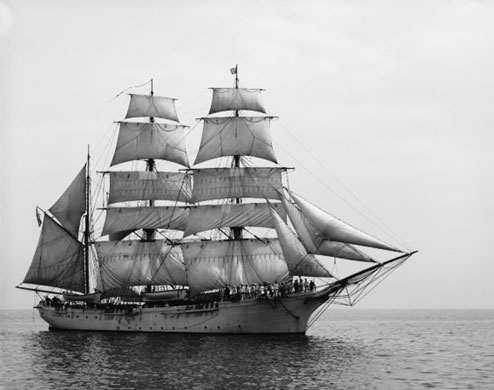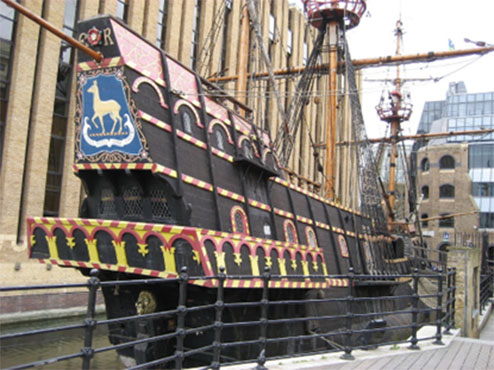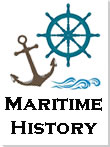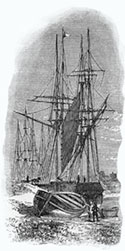Maritime History of Newport
By Peter Brown
© Peter Brown 2024
The sixteenth century
The turn of the 16th century (the end of the Middle Ages) marked a significant historical change in many respects, including seafaring. This period saw many changes, and by 1500 the Portuguese were already sailing around Africa to the Indian Ocean, and the first explorations were being made to the Americas. These changes required better ships for the long voyages and heralded a long period of innovation in ship design and construction, and with technology such as navigational aids. The changes in ship design were primarily connected to the number of masts and the number and types of sails used. This is sometimes called the shift to the full-rigged ships that later dominated.
Newport and Caerleon
We have little information about Newport in the early 16th century, but a survey of 1521 tells of “a burgh and a propur toune” with a haven able to accommodate even a large ship when the borough value was £18 10s. 5½d.[1] A 1522 Survey of the estates of the Duke of Buckingham states that Newport:[2]
haith a goodly haven commyng unto hit, well occupied with small Crayes whereunto a veray great shippe may resoorte and have good harbour. Upon the same haven is a proper Castell and III towers adioyning iuste to the water. The middelleste tower having a vowte or entre to receive into the said Castell a good vessel.
In 1587, the poet Thomas Churchyard described Newport as “Which Seate doth stand, for profite more than strength” where “This Market towne is buylt in healthfull sort: So downeward loe is many a Marchants shop, And many sayle to Bristowe from that Port.”[3] This confirms the other documentary references to the significance of the Bristol trade in the 16th century.
It is still unclear when Newport superseded Caerleon as the main port on the Usk, but the need for ships to pass under Newport Bridge to reach Caerleon was a limiting factor for trade, particularly when ships increased in size. Despite that, Caerleon was involved in overseas trade, and in the late 1530s, William Jones of Caerleon owned a ship of about 135 tons burden, referred to as the Trinity of Caerleon, the Trinity of Newport or the Trinity of Wales. This ship serviced Bristol’s trade to Lisbon and Andalucia and was the largest ship associated with either Newport or Caerleon. It was the only large Welsh ship to be called up for service in Henry VIII’s navy when England was threatened with invasion during 1539 and 1545.[4]
Trade
The sixteenth century provides us with detailed trade records for the first time. In 1541, the “Margaret de Newport” brought fish to Bristol; in 1551, the “Mary George de Newport” brought wine to Bristol, while “Le Ros de Newport” shipped cloth from Bristol.
Dr Thomas Paher visited the ports of Glamorgan and Monmouthshire in 1552 or 53. He wrote a report that tells us that a lot of leather and tallow was exported from those counties without a licence, being put aboard Bristol ships out in the Channel.[5] The report shows a substantial export trade from the ports of the South Wales coast in hides and other animal products.
The earliest Customs Books for the port of Bristol survive from 1565-70, and these show the names of the ships and their tonnages, the masters and merchants involved, and the journeys made. Newport ships listed are:[6]
- “LeTrinete de Newporte” (24 tons), sailing from “Korke” in Ireland to Bristol with a cargo of skins.
- “LeMychaell de Newporte” (14 tons), sailing from Newport to Bristol with goods for a Bristol mercer (a dealer in textile goods).
- “LeMarie Roze de Newporte” (20 tons), sailing from “Bristoll” and “Newporte” with 15 tons of brass and pewter ware and moving 6 tons of brass and pewter ware from Bristol to Aberthaw in Glamorganshire. Another journey carried items from several merchants in Waterford to Bristol, including “frice” (a coarse woollen cloth), “mantels”, “covarlets”, “blankets”, and sheep skins.
Caerleon ships listed are:[7]
- “Le Jesus de Carlene” (17 tons), sailing from Bristol to Carmarthen.
- “Le George de Carleene” (18 tons), sailing from Bristol to “Carleene” with 15 tons of brass and pewter, and later from “Carlyne” to “Bristoll” with 80 stone of wool.
- “Le Trynnetie de Carleene” (10 tons), sailing from Bristol to “Carleene” with “iron and 2 goodes cottens de Manchester.”
- Other Caerleon ships listed were “Le Marye de Carlyon” and “Le Marye Catheryne de Carlyon”, which also traded between the Usk and the Avon “with cargoes consisting mainly of brass, putere, linen, sope, drywares, wool, hides and dairy produce.”
In this period, the Society of Merchant Venturers of the City of Bristol was trading with the continent, and in 1577, the Crown granted the Spanish Company the sole right to trade with Spain and Portugal. Only London provided more merchants than Bristol as founding members of the Spanish Company.[8] The earliest entry in the first Merchant Venturers' Treasurer's Book is an account for 1583, including two Caerleon men, Alexander Lewis and Thomas James.[9] Also listed in these accounts are the Newport men Lewis Jenkin, Walter Abroll, William John Roser, John Joones and John Gascon. Jenkin and Abroll were listed as paying “for their freedom”.[10]
We also have evidence of Newport’s involvement with Atlantic shipping, when Miles Morgan of Tredegar Park captained one of the ships on Sir Humphrey Gilbert’s 1578 expedition from Plymouth across the Atlantic to start an English colony, carrying 122 guns and 409 men.[11] Morgan was captain of the Red Lyon, a tall ship of 110 tons and the third largest in the fleet of seven vessels that included Walter Raleigh as captain of the royal ship called the Falcon.[12] The expedition was unsuccessful, and Morgan was lost with the Red Lyon.
Customs Port Books for Cardiff survive from 1579 and include details of ships from Newport and Caerleon at the end of the 16th century.[13] Usk ships included:
- “Le Steven de Newporte” (30 tons), which sailed from Rochelle and Bordeaux to Newport carrying “2 tons Gascony and 6 tons of salt”, with a later journey from Rochelle to Newport carrying “6 tons of salt and 3 tons iron”.
- “Le Griffin de Caerlion” (35 tons), sailing from Lishbourn (Lisbon) to “Caerlion” with 18 tons of salt.
The Bristol Port Books from 1579-80 provide further details of trade connected to the Usk:[14]
- “Le Dragon de Newport” (100 tons) – also known as the Green Dragon – traded regularly between Bristol and Luxbo (Lisbon) carrying lead and “fardels” (bundels) of short “Somerset” cloths without grain (undyed), other cloths, and wax.
- “Le Griffane de Carlion” (50 tons) carrying 3 tons of lead from Bristol to St. Lucar (Sanlúcar de Barrameda in southern Spain).
- “Le Mary Roze de Newporte” (16 or 20 tons) from “Bristoll” to Newport carrying 4 dickers (units of 10) of tanned hide. She also sailed to Newport to tranship goods to “Le Whitt Beere” of Hull (50 tons), including “devonshire dozens” and other cloths, “12 hogsheads and 4 barrels containing 50 hendredweights of Rice.”
- “Le Griffown de Newport” (40 tons) also sailed from Bristol.
The Steven of Newport (30 tons) transported salt and iron from La Rochelle to Newport, while the Griffin of Caerleon (35 tons) returned to its home port from Lisbon on 25 March 1580 laden with 18 tons of salt belonging to a local merchant. This was presumably the aforementioned “Griffand of Caerleon”, which departed from Bristol eleven weeks earlier, bound for Andalusia.[15]
Records that survive from the 1580s also show the following:[16]
- The Rose of Newport (16 tons) sailed from Newport to Bristol with 3 dickers of tanned leather.
- The Dyamond of Poole (80 tons) sailed from London to Newport with 300 qtrs of rice.
- “Le Elizabeth de Teneby” (Tenby) (14 tons), “Le Trinity de Teneby” (8 tons) and “Le Elizabeth de Teneby” all sailed from “Teneby” with “qtrs of rye”.
The importance of the Usk as a shipping hub was shown again at the turn of the 17th century in the Book of Surveyor’s entries in the port of Cardiff.[17] The ships leaving Bristol in 1599-1600 included the Marie Rose of Newport and the Joseph, the Dolphin and the Margaret of Caerleon. The goods listed were large quantities of butter, wheat, oats, oatmeal, peas, cheese and wool, with the most regular entry being for kilderkins (barrels of 18 imperial gallons) of butter to be sent to Ireland. Supplies sent to Ireland then were for the English troops there, fighting a rebellion from 1593-1603.[18]
Ships
Although we have little information about the types of ships at Newport in the 16th century, there are intriguing references to the Trinity of Caerleon. In 1539 there were “Musters before Sir Wm Morgan, steward of the lordship of Uske, Caerllion, Trelech, with all the members…10 mariners of Caerllion, that were presented to serve the King in the ship called The Trinity of Caerllyon, Tho Hardyn, Master.”[19] A few months later, the ship was listed as one of 36 ships “now in the King’s wages at Portsmouth”, when each mariner received 5/- (shillings) per month of 28 days.
In 1550 the James of Newport was mentioned in the will of Sir William Herbert, who bequeathed her with "all manner of cabelle, anchors, ropes, tacklinge, guns, and ordynnce weapons" to his second son George.[20] The ordinance was also mentioned by George Herbert of St. Julians, who owned Le Steven and Le Dragon (or Green Dragon) already mentioned. When he died in 1580, his bequests included the following:[21]
Item. I give and bequeathe to Sir William Harbert of Sainte Julians, Knighte,…my ship called the Greene Dragon with all her ffurnyture and tacklynge, and Ordinance, Shott and Powdr, armes and munition.
Item. I give and bequeathe to my brother Myles Harberte, my bark called the Stephen with all her ffurnyture and tackelyne.
This reference to a “bark” (barque) is interesting as we have few precise references in the 16th century to the type of ships at Newport. Barques were sailing vessels with three or more masts and mainmasts rigged square, and only the mizzen (the aftmost mast) rigged fore and aft. Shakespeare's famous Sonnet 116 (dated 1609) contains the line: “It is the star to every wandring barke”.

This unidentified US ship shows the barque sail arrangements.
Reproduced under Creative Commons licence.
During the 16th century, trading ships were still generally small local vessels, but larger ships were also used, particularly for the overseas trade with France, Portugal and Spain. A return of shipping compiled in the Elizabethan period (the later 16th century) shows the importance of Newport as a trading centre with “Topmen”, being ships of less than 100 tons with a top to the mast. Bristol owned eight of these, Newport six, Swansea six and Cardiff two.[22] The Newport vessels then were:[23]
- Green Dragon (100 tons)
- White Eagle (100 tons)
- Griffand (40 tons)
- Lyon (40 tons)
- Black Lyon (34 tons)
- Steven (30 tons)
- Samuell (30 tons)
- Mary Rose (26 tons)
- Smaller vessels (up to 20 tons) included the Angell, Barthewe, George, Hare, Swallowe, Xpian and Cock.
Newport could boast two large ships over 100 tons, compared to Bristol’s eight. No other port or subport in the Bristol Channel could compare with this scale of shipping.[24]
In the 1582 census of English merchant shipping, almost 90% of the ships were of less than 100 tons burden. From the 1590s, the stock of larger ships increased with the growth of long-distance trade with Europe and elsewhere.[25]
The 16th century also saw the development of galleons as trading vessels, although initially used for war. They were full-rigged sailing ships with three or four masts, carrying square and fore-and-aft sails, with multiple decks, a square forecastle and a raised stern.[26] Mainly used by the Spanish and Portuguese (up until the early 19th century), they were common trade carriers used by Europeans from the 16th to the 18th centuries. The most famous British galleon was Drake’s Golden Hind, the second ship to circumnavigate the world in 1580. She was thought to have weighed around 120 tons and carried a crew of 80-85 with 22 guns.[27]

A modern replica of the Golden Hind at Southwark in London.
Reproduced under Creative Commons licence.
References
1 Griffiths, R. A. (1978) Boroughs of Mediaeval Wales, 207.
2 Dawson, J. W. (1932) Commerce and Customs: A History of the Ports of Newport and Caerleon.
Online at: https://archive.org/details/commerce-and-customs-newport , 4, citing State Papers (Domestic), Henry VIII, vol. 3, part 1. Also in Maylan, C. N. (1991) Proposed Usk Barrage Initial Archaeological Assessment, GGAT Report No. 91/01.
Online at: https://walesher1974.org/her/app/php/herumd.php?level=2&group=GGAT&docid=301464088&linktable=her_source1_link1991 , 11, citing TNA Exchequer E 36/150 of 1522.
3 Thomas Churchyard, The Worthines of Wales, 1587.
4 Jones and Stone (2018), The World of the Newport Medieval Ship, 79-80.
5 Kennerley, E. (1979), ‘River Trade and Shipping in Caerleon from the 16th to the 19th Century’, Gwent Local History, 47, citing W. R. B. Robinson, ‘The Establishment of Royal Customs in Glam. and Mons. under Eliz. I.’, Bull. of Celtic Stud. H & L, Vol. XXIII, Part IV, May 1970.
6 Dawson, 5.
7 Dawson, 6.
8 Kennerley, 1979; https://en.wikipedia.org/wiki/Spanish_Company
9 Kennerley, 1979.
10 McGrath, P. (1952) Records Relating to The Society of Merchant Venturers of the City of Bristol in the Seventeenth Century, Bristol Record Society Publication, 17, 83.
Online at: https://www.bristol.ac.uk/Depts/History/bristolrecordsociety/publications/brs17.pdf , 83.
11 Quinn, David Beers (1940) The Voyages and Colonising Enterprises of Sir Humphrey Gilbert, London: Hakluyt Society, 43.
12 Dawson, 11.
13 Dawson, 6-7.
14 Dawson, 7-9.
15 Jones and Stone, 86-7.
16 Dawson, 11-12.
17 Dawson, 16-17.
18 Kennerley, 1979.
19 Dawson, 4, citing State Papers (Domestic) Henry VIII, vol. 3, part 1.
20 Trett, Bob (2007) Newport Ships and Shipping in the late Middle Ages - A Chronology.
Online at: http://www.newportpast.com/early/port/dates.htm
21 Dawson, 10.
22 Dawson, 12.
23 Dawson, 12-13.
24 Dawson, 12.
25 Jones and Stone, 53.
26 https://www.britannica.com/technology/galleon ; https://en.wikipedia.org/wiki/Galleon
27 https://en.wikipedia.org/wiki/Golden_Hind
Back to Index of Peter Brown's "Maritime History of Newport "

